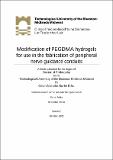| dc.description.abstract | Peripheral nerve injury is a worldwide issue affecting millions. More than 719,000 people are
receiving surgical treatment for peripheral nerve injury each year in the US alone. There is
presently a market for the repair of peripheral nerve injury using natural or synthetic nerve
grafts with the autograft (current gold standard) having well known drawbacks in the form of
donor site morbidity and a low rate of success for injuries greater than 3 cm. Therefore, there
is an opportunity in the market of peripheral nerve injuries to repair gaps greater than 3 cm
while also preventing secondary sites of morbidity. This thesis describes the development of a
polyethylene glycol dimethacrylate (PEGDMA) based product to fill this clinical need.
Initial work in this thesis focused on comparing the material property profiles of four different
monomer concentrations of PEGDMA (600MDa) stored in physiological solutions at 37°C
over a 28-day period. To achieve this goal, polymer constructs were prepared (25, 50, 75 and
100 wt. % PEGDMA) in water and cross-linked by UV-induced photopolymerisation.
Thereafter the material properties were examined after 0, 2, 14 and 28 days for their swelling
characteristics, wettability, surface topography, chemical properties, polymer morphology,
mechanical properties, and cell response. From this data, it was decided that the 50 and 100 wt.
% PEGDMA hydrogels were most suited to replicate the conditions of peripheral nerve tissue.
Electroactive bioglass was selected as an additive to increase the conductivity of PEGDMA to
enhance conductivity. The materials properties of the new PEGBio composites were
subsequently tested with additional analysis of the conductivity of samples. From these
subsequent tests it was determined that the PEGBio 2.5 wt. % samples provided the greatest
boost to conductivity. Following on from this the project looked to address PEGDMAs lack of
degradability. To improve degradability, PEGDMA was polymerised with ten different thiol
monomers, both mercaptopropionates and mercaptoacetates. Following an initial
polymerisation check, it was determined that mercaptopropionates were more successfully
polymerised than mercaptoacetates. The material properties of the new PEG-thiol composites
were subsequently tested as per previous tests with further study determining that
dipentaerythritol hexa(3-mercaptopropionate) (DiPETMP) successfully enhanced the
biodegradability of PEGDMA.
To increase the bioactivity of PEGDMA based hydrogels the introduction of bioactive factors
was analysed. A series of high-throughput tests combining three drugs (N-acetyl cysteine
(NAC), Ibuprofen (Ibu) and Progesterone (Prog)) were carried out to pick the most synergistic
three-drug combination to boost cellular proliferation in PC-12 and Schwann cells. Ultimately
concentrations of 75 µM NAC, 16.25 µM Ibu and 30 µM Prog were selected. Following this,
a study to determine the rates of NAC, Ibu and Prog release from PEGDMA-DiPETMP found
that drug release was completed after 1, 3 and 21 days respectively. In the final section of this
thesis, attempts were made to control the 3D architecture of the final composition, leading to a
combination of PEGDMA, DiPETMP, Bioglass and the drugs NAC, Ibu and Prog
(PEGCombo) being prepared via UV chamber polymerisation. Its properties were monitored
over a 28 day period, ultimately it was determined that further adjustments to PEGCombos
composition were needed to enhance its potential use as a nerve guidance conduit. | en_US |


